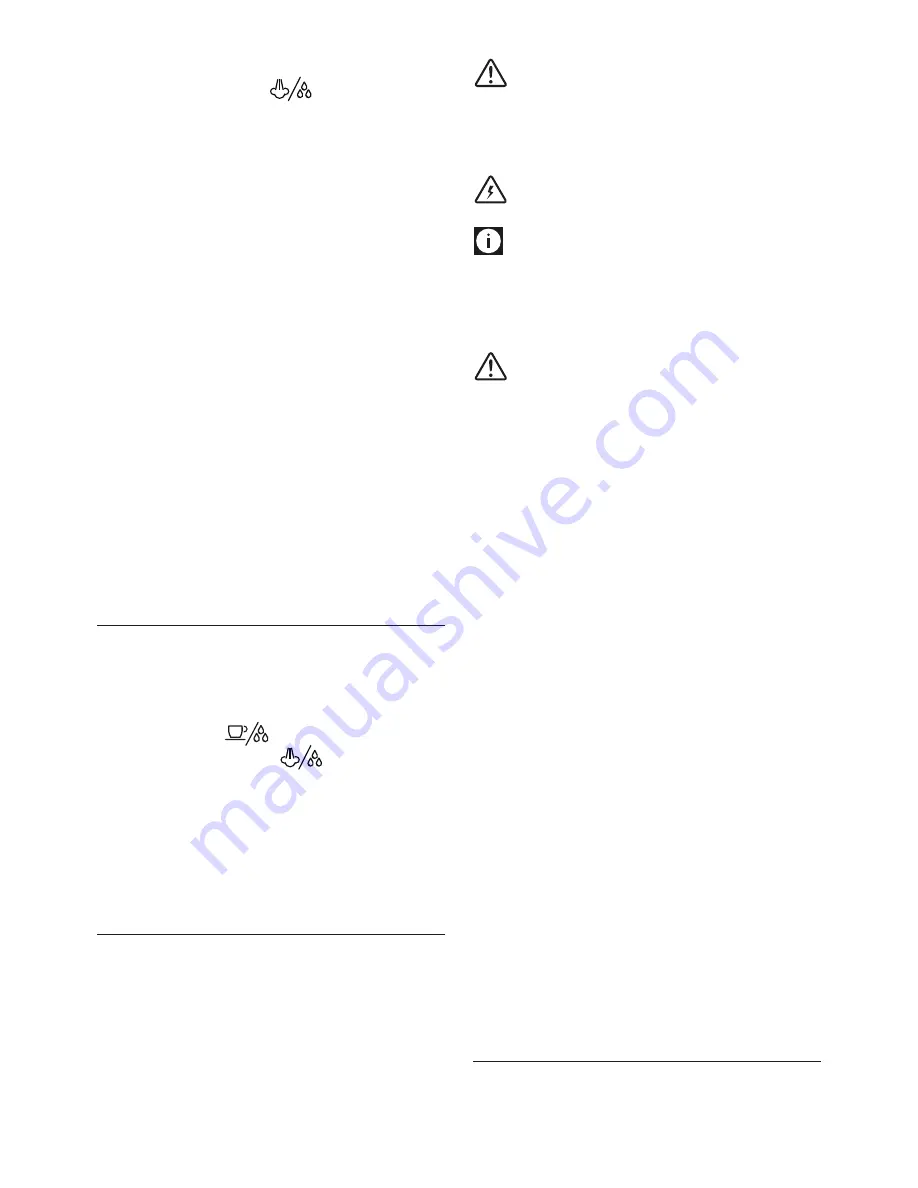
10
Proceed as follows:
1. Turn the steam dial to the
position (steps 2- 6 and
7 of the cap. “How to make cappuccino”. This causes the
cappuccino maker to discharge any milk left inside. Turn
the steam dial to
0
position and the selector dial to
ON
position;
2. Wait for a few minutes to allow the steam spout to cool.
Unscrew the cappuccino maker by turning it clockwise (fig.
20) and wash it thoroughly with warm water;
ECP3630 model
3. Remove the nozzle from by pulling it downwards (fig. 21);
4. Move the ring upwards and make sure the hole shown by
the arrow in fig. 22 is not blocked. If necessary, clean with
a pin;
5. Replace the nozzle, move the ring downwards and put the
cappuccino maker back on the nozzle, turning it and push-
ing it upwards until it is attached.
ECP3420 and ECP3220 models
3. Remove the nozzle from by pulling it downwards(fig. 23);
4. Make sure the holes shown in fig. 24 are not blocked. If
necessary, clean with a pin;
5. Replace the nozzle and the cappuccino maker back on
the nozzle, turning it and pushing it upwards until it is
attached.
HOT WATER
1. Turn the appliance on by turning the selector dial to ON
(fig. 4). Wait the
READY
indicator light comes on;
2. Place a recipient under the cappuccino maker;
3. When the
READY
indicator light comes on, turn the se-
lector dial to the
position and at the same time,
rotate the steam dial to the
position: Hot water is
delivered from the cappuccino maker;
4. To interrupt delivery of hot water, rotate the steam dial to
0
position and turn selector dial to
ON
.
You should not deliver hot water for more
than 60 seconds.
CLEANING
Cleaning the machine
The following parts of the machine must be cleaned regularly:
- the drip tray (A14)
- the coffee filters (C2, C3 and C4);
- the boiler outlet (A12);
- the water tank ( A1);
- the cappuccino maker (A7) as described in section “Claning
the cappuccino maker after use”.
Important!
• Do not use solvents, abrasive detergents or alcohol to clean
the coffee machine.
• Do not use metal objects to remove encrustations or coffee
deposits as they could scratch metal or plastic surfaces.
Danger!
While cleaning, never immerse the coffee
maker in water. It is an electrical appliance.
Please note:
If the appliance is not used for more than 3/4 days, before using it again, we strong-
ly recommend you rinse the internal circuits through as described in Setting up the
appliance”.
Cleaning the drip tray
Important!
The drip tray is fitted with a level indicator (red) showing the
level of water it contains. Before the indicator protrudes from
the cup tray (fig. 25), the drip tray must be emptied and cleaned,
otherwise the water may overflow the edge and damage the
appliance, the surface it rests on or the surrounding area.
1. Remove the drip tray (fig. 26);
2. Remove the cup tray, empty the water and clean the drip
tray with a cloth, then reassemble the drip tray. Extract the
mug of high glass tray (A13), clean with water, dry and put
it back in its housing;
3. Put the drip tray back in place.
Cleaning the coffee filters
Clean the coffee filters regularly by rinsing under running water.
Make sure the holes are not blocked. If necessary, clean with a
pin (fig. 27).
Cleaning the boiler outlet
After every 200 coffees, rinse the boiler outlet by delivering
about 0.5 l / 17 oz of water from the boiler outlet.
Cleaning the water tank
1. Clean the water tank regularly (about once a month) and
whenever you replace the water softener filter (C7, *if used)
with a damp cloth and a little mild washing up liquid;
2. Remove the filter (*if present) and rinse with running
water;
3. Replace the filter (*if provided), fill the tank with fresh
water and replace the tank.
DESCALING
We recommend descaling the coffee maker about every 200
coffees. We recommend using the De’Longhi descaler (purchase
separately).







